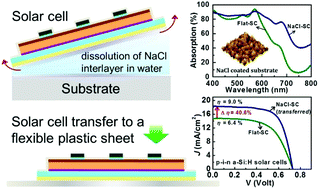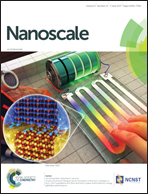Combining light-harvesting with detachability in high-efficiency thin-film silicon solar cells†
Abstract
Efforts to realize thin-film solar cells on unconventional substrates face several obstacles in achieving good energy-conversion efficiency and integrating light-management into the solar cell design. In this report a technique to circumvent these obstacles is presented: transferability and an efficient light-harvesting scheme are combined for thin-film silicon solar cells by the incorporation of a NaCl layer. Amorphous silicon solar cells in p-i-n configuration are fabricated on reusable glass substrates coated with an interlayer of NaCl. Subsequently, the solar cells are detached from the substrate by dissolution of the sacrificial NaCl layer in water and then transferred onto a plastic sheet, with a resultant post-transfer efficiency of 9%. The light-trapping effect of the surface nanotextures originating from the NaCl layer on the overlying solar cell is studied theoretically and experimentally. The enhanced light absorption in the solar cells on NaCl-coated substrates leads to significant improvement in the photocurrent and energy-conversion efficiency in solar cells with both 350 and 100 nm thick absorber layers, compared to flat-substrate solar cells. Efficient transferable thin-film solar cells hold a vast potential for widespread deployment of off-grid photovoltaics and cost reduction.



 Please wait while we load your content...
Please wait while we load your content...